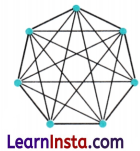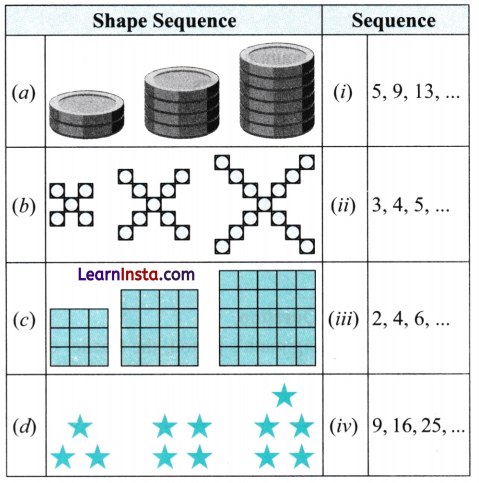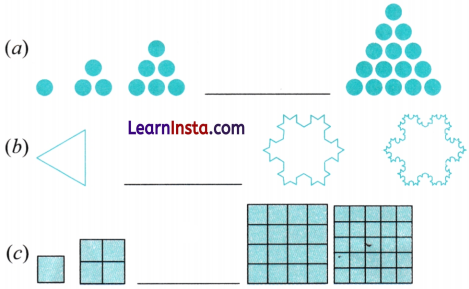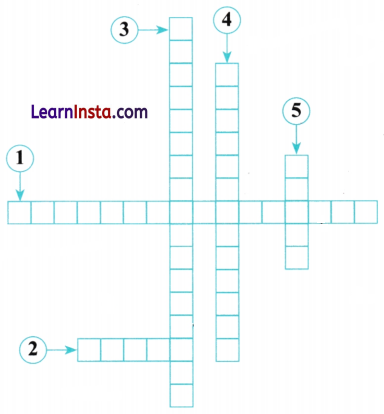MCQ on Patterns in Mathematics Class 6
Class 6 Maths Chapter 1 MCQ Patterns in Mathematics
I. Multiple Choice Questions
Question 1.
Which of the following numbers can be represented as a triangle and a square shape?
(a) 15
(b) 21
(c) 36
(d) 49
Answer:
(c) 36
Question 2.
The sum of two consecutive triangular numbers is a
(a) square number
(b) cube number
(c) hexagonal number
(d) Virahanka number
Answer:
(a) square number
![]()
Question 3.
The sum of first 11 consecutive odd numbers is __________________
(a) 22
(b) 33
(c) 77
(d) 121
Answer:
(d) 121
Question 4.
How many lines are there in all the given polygon?

(a) 14
(b) 21
(c) 28
(d) 35
Answer:
(b) 21
Question 5.
Assertion: 1 + 3 + 5 + 7 + 9 + 11 + 13 + 15 + 17 + 19 = 100
Reason: By adding up n consecutive odd numbers, we get square of number n.
In the given question, a statement of Assertion is followed by a statement of Reason. Choose the correct option as:
(a) Both assertion and reason are true and the reason is the correct explanation of assertion.
(b) Both assertion and reason are true but the reason is not the correct explanation of the assertion.
(c) Assertion is true and the reason is false.
(d) Assertion is false and the reason is true.
Answer:
(a) Both assertion and reason are true and the reason is the correct explanation of assertion.
Question 6.
Which sequence represents the number of triangles in each row of stacked triangles? [Easy]
(a) Square numbers
(b) Triangular numbers
(c) Fibonacci numbers
(d) Prime numbers
Answer:
Option (b) is correct
Explanation:
The stacked triangles form a pattern where each row has one more triangle than the previous, following the triangular number sequence.
Question 7.
What is the formula for calculating the number of edges in a complete graph with n vertices?
(a) n(n + 1)
(b) n²
(c) \(\frac{n(n-1)}{2}\)
(d) 2n
Answer:
Option (c) is correct
Explanation:
This formula counts the number of unique pairs of vertices that can be connected by edges in a complete graph.
Question 8.
What shape is added to each side of the Koch snowflake in every iteration? [Easy]
(a) Circle
(b) Square
(c) Triangle
(d) Hexagon
Answer:
Option (c) is correct
Explanation:
Each line in the Koch snowflake is replaced by a bump that forms a smaller triangle.
Question 9.
The sequence 1,4,9,16… is known as [Easy]
(a) fibonacd sequence.
(b) square numbers.
(c) triangular numbers.
(d) prime numbers.
Answer:
Option (b) is correct
Explanation:
These numbers are the squares of natural numbers, representing a square number pattern.
Question 10.
Why does the Koch snowflake pattern become more detailed with each iteration? [Medium]
(a) Because more lines are added
(b) Because lines are replaced by smaller shapes
(c) Because the triangles get larger
(d) Because new shapes are added randomly
Answer:
Option (b) is correct.
Explanation:
Each time, every line is replaced by four smaller segments, making the pattern more detailed.
Question 11.
The Koch snowflake has a finite perimeter after infinite iterations. (True/False) [Medium]
Answer:
False
Explanation:
The perimeter of the Koch snowflake keeps getting longer with each iteration and can become infinite, even though its area stays finite.
Question 12.
Stacked squares form a sequence of triangular numbers. (True/False) [Easy]
Answer:
False
Explanation:
Stacked squares form a sequence of square numbers (1, 4, 9, 16…), not triangular numbers.
Question 13.
Assertion (A): The number of edges in a complete graph with 5 vertices is 10. [Medium]
Reason (R): The number of edges in a complete graph is given by \(\frac{n(n-1)}{2}\).
(a) Both A and R are true and R is the correct explanation of A.
(b) Both A and R are true, but R is not the correct explanation of A.
(c) A is true, but R is false.
(d) A is false, but R is true.
Answer:
Option (a) is correct
Explanation:
For n = 5, the number of edges is
\(\frac{5(5-1)}{3}=\frac{20}{2}\) = 10
Question 14.
Assertion (A): The Koch snowflake becomes smoother with each iteration. [Medium]
Reason (R): Each iteration adds smaller and smaller triangles to the snowflake.
(a) Both A and R are true and R is the correct explanation of A.
(b) Both A and R are true, but R is not the correct explanation of A.
(c) A is true, but R is false.
(d) A is false, but R is true.
Answer:
Option (d) is correct.
Explanation:
The Koch snowflake actually becomes more jagged and detailed with each iteration, not smoother.
Question 15.
Assertion (A): Stacked triangles follow a triangular number sequence. [Easy]
Reason (R): In each new shape, one more row of triangles is added compared to the previous shape.
(a) Both A and R are true and R is the correct explanation of A.
(b) Both A and R are true, but R is not the correct explanation of A.
(c) A is true, but R is false.
(d) A is false, but R is true.
Answer:
Option (a) is correct.
Explanation:
The growing number of rows in stacked triangles creates a triangular number sequence. This sequence if formed when a new triangle is added in each next row.
Name the following number sequences:
(a) 1, 2, 3, 4, 5, 6, 7,……….
Answer:
Counting Numbers
(b) 1, 3, 5, 7, 9, 11, 13,……….
Answer:
Odd Numbers
(c) 2, 4, 6, 8, 10, 12, 14,…….
Answer:
Even Numbers
(d) 1, 3, 6, 10, 15, 21, 28,…….
Answer:
Triangular Numbers
(e) 1, 4, 9, 16, 25, 36, 49,……….
Answer:
Square Numbers or Squares
(f) 1, 8, 27, 64, 125, 216,………
Answer:
Cube Numbers or Cubes
(g) 1, 2, 3, 5, 8, 13, 21,……..
Answer:
Virahanka Numbers
![]()
Match the following:
Question 1.
| (a) 1 + 3 + 5 + 7 + 9 + 11 | (i) Square of 4 |
| (b) 1 + 7 + 19 + 37 | (ii) Square of 99 |
| (c) 1 + 2 + 3 +…..+ 99 + 98 +…..+ 3 + 2 + 1 | (iii) Square of 6 |
| (d) 1 + 3 + 5 + 7 | (iv) Cube of 4 |
Answer:
| (a) 1 + 3 + 5 + 7 + 9 + 11 | (iii) Square of 6 |
| (b) 1 + 7 + 19 + 37 | (iv) Cube of 4 |
| (c) 1 + 2 + 3 + ….. + 99 + 98 + …… + 3 + 2 + 1 | (ii) Square of 99 |
| (d) 1 + 3 + 5 + 7 | (i) Square of 4 |
Question 2.

Answer:
(a) (iii)
(b) (i)
(c) (iv)
(d) (ii)
Complete the following shape sequences:

Answer:

Fun Activity
Complete the following crossword puzzle:

Directions:
Across:
(1) The sequence 1, 1 + 6, 1 + 12, 1 + 18, represents __________________
(2) The set of counting numbers along with 0 is known as __________________ numbers.
Down:
(3) The number sequence 1, 3, 6, 10, 15,…… represents __________________
(4) The sequence 1, 1 + 2 + 1, 1 + 2 + 3 + 2 + 1,…… represents __________________
(5) The number sequence 1, 8, 27, 64, 125,….. represents __________________
Answer:
Across
(1) Hexagonal Numbers
(2) Whole
Down
(3) Triangular Numbers
(4) Square Numbers
(5) Cubes
![]()
Case-Based Question
One day during math’s period, the teacher organised a game based on number theory using number cards. She prepared 50 numbered cards numbering from 1 to 50 and asked the class is to put these cards in 4 boxes, labelled as triangular numbers, square numbers, hexagonal numbers and cube numbers.
Based on the above information, answer the following questions.
(a) If Rohan picks the number card of 25, then in which box will he drop the card?
Answer:
Square Numbers
(b) If Riya wants to choose the highest hexagonal number, which number will she pick up?
Answer:
45
(c) If Soham chooses the card of number which is both triangular and square number, then which number card has he chosen?
Answer:
36